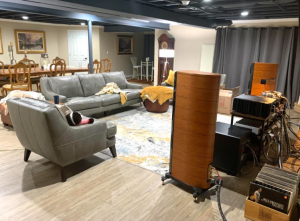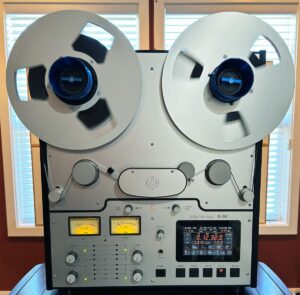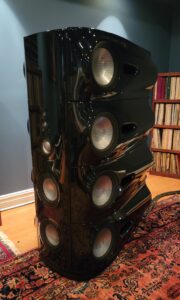Roger Skoff writes about dealing with something that affects us all
There's no denying that inflation is real. When Eater magazine recently described a $23 Brooklyn hamburger as "controversial" and the thing they said was controversial about it was not its price but the mustard, catsup, and maple syrup sauce used on it (HERE), it was easy to tell that—whether or not it's here to stay, inflation is definitely here for now, and we're going to have to live with it for as long as it lasts.
It's not just hamburgers and gas prices that seem to have gone berserk: 99 cent stores now charge $1.49; a street burrito is up to $10 in some places; and everything else seems to have gone up, too—not just by the officially declared percentage, but at a rate that has to be causing some serious re-thinking by a whole lot of people on a whole lot of subjects.
One of those subjects is our hi-fi hobby, where just about everything seems to have gotten conspicuously more expensive in recent times, and where, in talking with dealers, what I'm hearing is that the market is breaking down into really only two active areas: entry-level products and the very High-End.
Up at the extreme High-End, expense doesn't really seem to matter; those who can afford the very best can still afford it and that market segment seems to be doing just fine. For the rest of us, though—for the audiophiles and music lovers who can't afford to pay as much for their system as others might expect to pay for a house—here are some ideas for getting the very best sound for every dollar you spend.
- If you're looking to buy speakers, don't buy floor-standing ones.
There are several good reasons for this: The first is that, unless you have a very large room to listen to them in, large speakers might simply be a waste of money. To reproduce a 30Hz waveform, for example—a solid deep bass note, but still half an octave above what's normally said to be the lower limit of human hearing—your listening room would have to have a minimum longest dimension of more than 18 feet (5.58 meters). If it's not that big, it just can't do it. Period. It's that simple, so why not buy a (usually smaller) speaker of more limited bass capability? A pair that only goes down to 40Hz, for example, would produce its bottom frequency in only 13 3/4 feet (4.2 Meters), which would not only be more suitable to the dimensions of the average listening room, but the speakers would cost a whole lot less, too.
Low bass frequencies are the most expensive part of the sonic spectrum to reproduce. They require more and/or bigger drivers, housed in bigger and/or more complex/harder to build enclosures, and all of those things can add considerably to a speaker's expense.
The bigger size of the enclosure can be a negative factor, just in itself. Great big floor-standing speakers can be a problem from the standpoint of fitting in to one's décor. They take up lots of space. They're certainly not likely to be inconspicuous. They're hard to move and can be harder to find the proper placement for, both sonically and as related to the rest of the room's furnishings. And, because of their shape and large frontal area, it's more likely that large speakers will have diffraction-caused imaging problems than small ones.
Smaller speakers, on the other hand, can have some definite advantages: First of all, they're likely to be cheaper. That's because of their smaller or fewer bass drivers, their smaller and/or less complex and expensive enclosures, and because they tend to be two-way, instead of three-way designs, with accordingly less complex and costly crossover networks.
Also, because they tend to use the same tweeter and mid-range driver (if any) as the larger, more expensive, speakers from the same manufacturers, they tend to sound— except in the deep bass range (which your room may not be capable of reproducing, anyway)—exactly like those larger models. In fact, because stand-mounted two-way speakers will likely have less refractive frontal area and may be more time-coherent than more expensive floor-standing models of the same brand and series, they may actually sound, image, and soundstage better!
Try it. If you decide you really need more bottom end, and want to try to force it, you can always add a subwoofer later—possibly for less money than the amount you saved by not buying the larger, "full-range" model of the same speakers you bought in the first place.
- If you're looking to buy electronics
Here's the trick for this: The larger consumer electronics manufacturers usually try to maximize their sales by offering more than just a single model or line of whatever kind of component you may be looking for—an amplifier, preamp, tuner, disc player, streamer or whatever else. In fact, I can remember a time not too many years ago when one Japanese giant had receivers (just as one example) in "budget," "better," "best," and "High-End" product lines, and at several price points within those lines to cater to as many different markets, and be sold through as many different outlets as possible.
In fact, as I recall it, above a basic starting point, they seemed to have one of their receivers priced just thirty or forty dollars apart along the entire price spectrum.
And what was the difference between them? In some cases, none. Some products or lines were identical, but simply given different model names or numbers so that different "Big Box" or HiFi stores could all claim to have an "exclusive" on them. Even where there was a difference, most of the receivers (or cd players, or integrated amps, or whatever) were built on the same chassis and from the same components. Where they were different was in (a.) brand or model name, (b.) cosmetics (color, finish, knobs, dials, etc.) (c.) features (tone controls, filters, DSP, etc.), or (d.) the quality, output, or performance of the included operating sections (power supply, amplifier, tuner, DAC, etc.)
Generally, the way it worked was that the entry-level model in any line had that line's basic operating modules but nothing extra—no added features or performance, and minimal cosmetic appeal. The next model in that line added features, and maybe a little higher performance, but all the models of that line were little more than ever-fancier versions of the same thing. The next line up went to the next level of operating modules (probably better power-supply and output sections), but started, as before, with few or no features, only adding those as each product in the line got more and more expensive.
The most important thing about products marketed that way was that the highest priced product in any cheaper line might actually be more expensive than the lowest-priced product in the next line up! And that's the thing you can take advantage of. If they're anywhere near the same price, always buy the cheapest product in the higher-priced line instead of the "top" model in a lower-priced one. Odds are you'll get fewer features (which you'll likely to use seldom or never anyway) and get better sound because of a better power supply, a better output section, possibly better components and circuitry, and (if it's tubes) maybe even better transformers. Whichever it is, that's the way to make sure—even from smaller manufacturers—to get the best performance for your purchase dollar.
- Software – should you buy it or stream it?
Looking at my music collection, I see LP and CD recordings that must, over time, have cost me at least sixty or seventy thousand dollars. Although that's not much in comparison with some other collections I've seen, it's still enough to make me wonder if—had it been available to me—I might not have been better-off streaming the music as I desired it instead of buying it to have as my own. The simple fact is that many of my records have only been played a few times or less, and some have never been played at all. As I wrote in an article some months ago, I've been trying to go through my whole collection, one at a time, but at this rate it may take years until I've heard or re-heard them all.
There's certainly the possibly that among them are collector's items (especially the un-played ones) that will some day be worth a great deal. But I'm thinking now that I might have been better off keeping the money in my pocket or doling it out for music as I wished to hear it than in having the value of a very nice system tied-up in software that I may never hear again.
Not buying music, but just paying to access it might be—especially in these inflationary times—a good way to "have your cake and eat it, too."


































